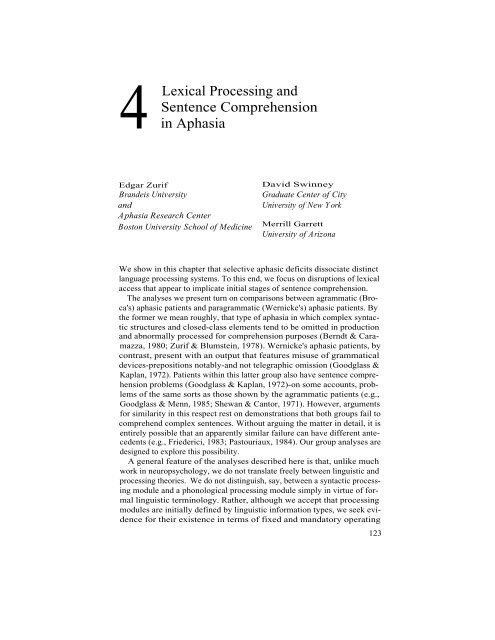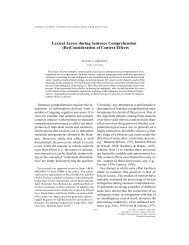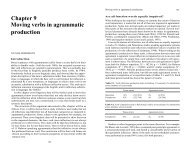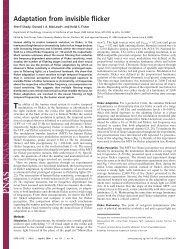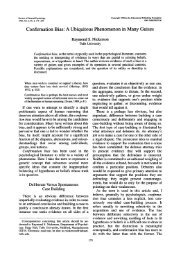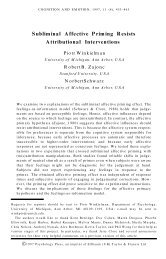4 Lexical Processing and Sentence Comprehension in Aphasia
4 Lexical Processing and Sentence Comprehension in Aphasia
4 Lexical Processing and Sentence Comprehension in Aphasia
Create successful ePaper yourself
Turn your PDF publications into a flip-book with our unique Google optimized e-Paper software.
4<strong>Lexical</strong><strong>Process<strong>in</strong>g</strong> <strong>and</strong><strong>Sentence</strong> <strong>Comprehension</strong><strong>in</strong> <strong>Aphasia</strong>Edgar ZurifBr<strong>and</strong>eis University<strong>and</strong><strong>Aphasia</strong> Research CenterBoston University School of Medic<strong>in</strong>eDavid Sw<strong>in</strong>neyGraduate Center of CityUniversity of New YorkMerrill GarrettUniversity of ArizonaWe show <strong>in</strong> this chapter that selective aphasic deficits dissociate dist<strong>in</strong>ctlanguage process<strong>in</strong>g systems. To this end, we focus on disruptions of lexicalaccess that appear to implicate <strong>in</strong>itial stages of sentence comprehension.The analyses we present turn on comparisons between agrammatic (Broca's)aphasic patients <strong>and</strong> paragrammatic (Wernicke's) aphasic patients. Bythe former we mean roughly, that type of aphasia <strong>in</strong> which complex syntacticstructures <strong>and</strong> closed-class elements tend to be omitted <strong>in</strong> production<strong>and</strong> abnormally processed for comprehension purposes (Berndt & Caramazza,1980; Zurif & Blumste<strong>in</strong>, 1978). Wernicke's aphasic patients, bycontrast, present with an output that features misuse of grammaticaldevices-prepositions notably-<strong>and</strong> not telegraphic omission (Goodglass &Kaplan, 1972). Patients with<strong>in</strong> this latter group also have sentence comprehensionproblems (Goodglass & Kaplan, 1972)-on some accounts, problemsof the same sorts as those shown by the agrammatic patients (e.g.,Goodglass & Menn, 1985; Shewan & Cantor, 1971). However, argumentsfor similarity <strong>in</strong> this respect rest on demonstrations that both groups fail tocomprehend complex sentences. Without argu<strong>in</strong>g the matter <strong>in</strong> detail, it isentirely possible that an apparently similar failure can have different antecedents(e.g., Friederici, 1983; Pastouriaux, 1984). Our group analyses aredesigned to explore this possibility.A general feature of the analyses described here is that, unlike muchwork <strong>in</strong> neuropsychology, we do not translate freely between l<strong>in</strong>guistic <strong>and</strong>process<strong>in</strong>g theories. We do not dist<strong>in</strong>guish, say, between a syntactic process<strong>in</strong>gmodule <strong>and</strong> a phonological process<strong>in</strong>g module simply <strong>in</strong> virtue of formall<strong>in</strong>guistic term<strong>in</strong>ology. Rather, although we accept that process<strong>in</strong>gmodules are <strong>in</strong>itially def<strong>in</strong>ed by l<strong>in</strong>guistic <strong>in</strong>formation types, we seek evidencefor their existence <strong>in</strong> terms of fixed <strong>and</strong> m<strong>and</strong>atory operat<strong>in</strong>g123
124 ZURIF, SWINNEY, GARRETTcharacteristics-that is, <strong>in</strong> terms of a functional architecture elaborated <strong>in</strong>real-time terms (Fodor, 1983; Pylyshyn, 1983). We return to this po<strong>in</strong>t <strong>in</strong>the context of the two experiments reported here.GRAMMATICAL CLASS EFFECTSIN SENTENCE PROCESSINGThe first of these studies turns on our efforts to characterize a sentencepars<strong>in</strong>g device based on closed-class vocabulary elements <strong>and</strong> relatedly, toreconstruct features of agrammatic comprehension on the basis of a disruptionto this device.The <strong>in</strong>itial l<strong>in</strong>e of observations support<strong>in</strong>g this set of possibilitiesstemmed from a number of lexical decision tasks-tasks <strong>in</strong> which subjectsmust decide if a letter str<strong>in</strong>g does or does not form a word <strong>in</strong> their language.Normal subjects were observed to respond <strong>in</strong> systematically differentways to open-class <strong>and</strong> closed-class items. Their reaction times foropen-class words but not for closed-class words were found to be frequencysensitive. Also, they showed sensitivity to potential word formation processesfor open-class items but not for closed-class items, this latter be<strong>in</strong>gmanifested as an <strong>in</strong>terference effect-an elevation <strong>in</strong> judgment time-fornonword judgments when the nonwords conta<strong>in</strong>ed content word stems. So,for example, they took longer to classify casterty as a nonword than theydid nacherty, cast but not nach be<strong>in</strong>g an open-class item. This <strong>in</strong>terferenceeffect did not occur, however, for nonwords <strong>in</strong> which the first syllable was aclosed-class item: sucherty took no longer to be classified as a nonwordthan did nacherty. In effect, the closed class seemed to be contacted <strong>in</strong>some fashion that elim<strong>in</strong>ates <strong>in</strong>terference from a partial analysis as the <strong>in</strong>putis be<strong>in</strong>g processed (Bradley, 1978).Importantly, however, agrammatic patients did not show this <strong>in</strong>sulationeffect for the closed class. Nor did they show frequency <strong>in</strong>sensitivity forclosed-class recognition <strong>in</strong> the first mentioned task. In short, on both tasks,agrammatic patients treated closed-class items as they did open-class items(Bradley, 1978; Bradley, Garrett, & Zurif, 1980).These observations were <strong>in</strong>terpreted by Bradley et al. (1980) as evidencefor a differential impairment of two normally dist<strong>in</strong>ct forms of word retrieval.By hypothesis, the closed-class access system was taken normally toprovide essential <strong>in</strong>put to a parser (i.e., to a device that assigns a syntacticanalysis to the <strong>in</strong>put), <strong>and</strong> the agrammatic patients' apparent <strong>in</strong>ability toexploit this system was thus argued to provide a plausible account of theirsyntactic problems <strong>in</strong> comprehension. This argument was strengthened,moreover, by evidence that the failure to dist<strong>in</strong>guish the two word classes onthese tests was not a consequence of bra<strong>in</strong> damage <strong>in</strong> general, but was tiedto patients whose syntactic limitations demonstrably implicated elements of
4. LEXICAL PROCESSING AND SENTENCE COMPREHENSION 125the closed class. Several mild Wernicke's (or possibly gnomic) patients weretested with the same materials <strong>and</strong> they showed the normal dissociationpatterns (Bradley et al., 1980).Some aspects of these orig<strong>in</strong>al observations have not been uniformly replicated.In particular, the general claim that closed-class access is not frequencysensitive is questionable (Gordon & Caramazza, 1982; Segui,Mehler, Frauenfelder, & Morton, 1982). For English language materials, itseems likely that item selection, word length, <strong>and</strong> range of frequency sampledare important factors <strong>in</strong> determ<strong>in</strong><strong>in</strong>g the experimental outcome (e.g.,Egido & Garrett, 1981). Yet, although the status of claims for frequencybased differences between open- <strong>and</strong> closed-class words <strong>in</strong> lexical decisiontasks is thoroughly mixed, we have been impelled to a certa<strong>in</strong> stubbornness<strong>in</strong> pursu<strong>in</strong>g part of an account of agrammatic comprehension <strong>in</strong> terms of adisruption to the normal mode of contact<strong>in</strong>g closed-class representations.Our cont<strong>in</strong>ued <strong>in</strong>terest <strong>in</strong> this possibility has turned on a number of factors.There are, first of all, the observations that, whatever the nature of theantecedent disruption(s), agrammatic patients are unable to make normaluse of closed-class items for comprehension (e.g., Berndt & Caramazza,1980). And so far as normal process<strong>in</strong>g is concerned, there rema<strong>in</strong> a numberof replicable <strong>and</strong> <strong>in</strong>dividually persuasive observations-apart from frequencyeffects-<strong>in</strong>dicat<strong>in</strong>g that the features govern<strong>in</strong>g open-class access aredifferent from those govern<strong>in</strong>g access of the closed class. This differenceappears to implicate early, automatic (i.e., unconscious) mechanisms ofword recognition. We have already cited the <strong>in</strong>terference effect for nonwordjudgments <strong>in</strong> this respect (Bradley, 1978; Bradley et al., 1980). There are, <strong>in</strong>addition, a number of visual hemifield effects implicat<strong>in</strong>g open-closed classaccess differences-that is, observations that the two classes are treated differently<strong>in</strong> the right visual field but not the left (Bradley & Garrett, 1983;Shapiro & Jensen, 1986). And there is a general class of effects that <strong>in</strong>dicatea difference between the two classes <strong>in</strong> their availability for conscious report(Garcia-Alba & Sanchez-Casas, 1983; Haber & Sch<strong>in</strong>dler, 1981;Healy, 1976; Mundie, 1980). It is this last set of effects-the so-called <strong>in</strong>visibilityeffects-that we have most recently used as a means of analyz<strong>in</strong>gnormal <strong>and</strong> aphasic performance <strong>and</strong> on which we report here. (See alsoRosenberg, Zurif, Bownell, Garrett, & Bradley, 1985.)The particular task that we used was a letter cancellation task. Whenneurologically <strong>in</strong>tact subjects are faced with the requirement to cross outtarget letters <strong>in</strong> a text, they are more apt to notice <strong>and</strong> cancel the letterswhen they appear <strong>in</strong> open-class words than when <strong>in</strong> closed-class words.These experimental f<strong>in</strong>d<strong>in</strong>gs are <strong>in</strong>formally confirmed by one's normal impressionof proofread<strong>in</strong>g experience <strong>in</strong> which <strong>in</strong>versions <strong>and</strong> repetitions ofclosed-class items seem more likely to be overlooked than similar errors <strong>in</strong>volv<strong>in</strong>gopen-class elements. In some sense, then, properties of closed-classitems less readily <strong>in</strong>trude themsely s <strong>in</strong>to conscious attention-they tend to-
4. LEXICAL PROCESSING AND SENTENCE COMPREHENSION 127were each comprised one closed-class item (e.g., BUT), one high frequencyopen class item (e.g., PUT), <strong>and</strong> one low frequency open-class item(e.g. BAT). In each such triplet, the closed-class item was approximately10 times more frequent that the high frequency open-class item, which, <strong>in</strong>turn, was approximaely 10 times more frequent than the low frequencyopen-class item. In addition to the three prose passages, we prepared ascrambled word version of one of the passages, <strong>in</strong> which the words with<strong>in</strong>each sentence were r<strong>and</strong>omly ordered.We tested neurologically <strong>in</strong>tact patients, agrammatic aphasic patients,<strong>and</strong> Wernicke's aphasic patients with this material. To m<strong>in</strong>imize taskspecificstrategies, the patients were <strong>in</strong>structed to read each passage at normalspeed <strong>and</strong> they were timed with a stopwatch to encourage them not toread more slowly than they do normally. Further, they were asked multiplechoice questions <strong>in</strong> the middle <strong>and</strong> at the end of each of the passages to ensurethat they were read<strong>in</strong>g for mean<strong>in</strong>g <strong>and</strong> not just scann<strong>in</strong>g the letters.F<strong>in</strong>ally, <strong>and</strong> as forecast, <strong>in</strong> order to determ<strong>in</strong>e how resistant the openclosedclass difference is to attentional dem<strong>and</strong>s, we <strong>in</strong>structed a subset ofthe neurologically <strong>in</strong>tact subjects to pay special attention to small wordslike by or such, as these are often neglected on the task.The data we obta<strong>in</strong>ed are rather straightforward. First, the neurologically<strong>in</strong>tact subjects: We confirmed previous reports that they are less able to detecttarget letters <strong>in</strong> closed-class items than <strong>in</strong> open-class items. In addition,we observed no effect of frequency per se on the error pattern. That is,when we considered performance for targets embedded <strong>in</strong> the tripletsstepped <strong>in</strong> frequency, we found a significantly higher proportion of detectionerrors <strong>in</strong> the closed-class items than <strong>in</strong> the high <strong>and</strong> low frequencyopen-class items, but no significant difference between the high <strong>and</strong> lowfrequency items with<strong>in</strong> the open class. We also found the normal openclosedclass target detection difference to be significant <strong>in</strong> the prose conditionbut not <strong>in</strong> the scrambled condition, <strong>in</strong>dicat<strong>in</strong>g that the <strong>in</strong>visibility ofclosed-class items is <strong>in</strong> some way dependent on sentence pars<strong>in</strong>g <strong>and</strong> <strong>in</strong>terpretation.And we noted no significant performance differences betweensubjects who were specifically <strong>in</strong>structed to attend to the closed class <strong>and</strong>those who were not forewarned, suggest<strong>in</strong>g that the greater number ofclosed-class errors observed on this task reflects the operation of a normallyautomatic <strong>and</strong> impenetrable process<strong>in</strong>g mechanism. Of course, aclear c<strong>and</strong>idate for such a mechanism is the closed-class word retrieval systemthat we have described-the system that is, by hypothesis, <strong>in</strong> the serviceof a parser.With respect to the aphasic patients, we found that for st<strong>and</strong>ard prose,the Wernicke's patients, like the neurologically <strong>in</strong>tact patients, were less ableto detect target letters <strong>in</strong> closed-class items than <strong>in</strong> open-class items,whereas the agrammatic aphasic patients detected targets with an almostequal facility <strong>in</strong> the two vocabulary classes. These data are also compatible
128 ZURIF. SWINNEY, GARRETTwith our functional analysis. Thus, the agrammatics' relatively equal numberof errors on open- <strong>and</strong> closed-class targets may reasonably be viewed asreflect<strong>in</strong>g a disruption of the structurally relevant closed-class access <strong>and</strong>analysis route. <strong>and</strong> as the Wernicke's data make clear, this process<strong>in</strong>g problemis selectively tied to the overt features of agrammatism <strong>and</strong> not to theconsequences of bra<strong>in</strong> damage <strong>in</strong> general. 1It should be noted, however, that the Wernicke's patients did not performentirely normally on these tasks either. The pert<strong>in</strong>ent data <strong>in</strong> this respect arethose obta<strong>in</strong>ed <strong>in</strong> the scrambled word condition: As already remarked, thenormals showed much less of an open-closed class difference <strong>in</strong> this conditionthan they did with normal prose; by contrast, the Wernicke's patientsshowed very little shift from the pattern observed for them on the prosecondition. Their closed-class access <strong>and</strong> pars<strong>in</strong>g mechanism may, therefore,be hypothesized to be less than normally tied to the exigencies of <strong>in</strong>terpretivesystems. The effects of damage to the tissue implicated <strong>in</strong> Wernicke'saphasia may spare the ability to construct phrasal constituents (via theclosed class route, at least), but" these constructions cannot then be mappednormally onto semantically <strong>in</strong>terpretable levels. Alternatively, one may supposethat for normals the mapp<strong>in</strong>g is effected <strong>and</strong> rejected on <strong>in</strong>terpretivegrounds, but that this feedback <strong>in</strong>fluence is lost for Wernicke's patients.These last possibilities for Wernicke's raise the question: How can a devicethat provides <strong>in</strong>put to a parser persist <strong>in</strong> its operation when faced withunparsable (scrambled prose) passages? The answer we th<strong>in</strong>k turns on thenotion of impenetrability (Fodor, 1983; Pylyshyn, 1983): One facet of aform-driven or bottom-up device-of the sort that we characterized <strong>in</strong> ourdiscussion of the closed-class route-is that it accesses lexical <strong>in</strong>formation,but does not evaluate the context <strong>in</strong> which the item appears (nor, relatedly,1 Two earlier studies by Ross (1983) <strong>and</strong> by Locke <strong>and</strong> Deck (1982) us<strong>in</strong>g the st<strong>and</strong>ard letterdetection paradigm have been recorded <strong>in</strong> the literature. Our results differ from those of Ross,who reported the normal detection pattern for anteriorly lesioned patients; but our data are <strong>in</strong>agreement with those reported by Locke <strong>and</strong> Deck for a similar group. In both these otherstudies, however, the manner of patient classification makes the results difficult to <strong>in</strong>terpret <strong>in</strong>relation to agrammatism. Both studies dist<strong>in</strong>guish patients on the basis of lesion site-broadly,anterior versus posterior; <strong>and</strong> neither <strong>in</strong>dicated the degree to which the behavioral features ofagrammatism were present. It seems likely, then, that patient selection differences underlie thevariations <strong>in</strong> the outcome of these studies.In this respect, we cannot ignore the pitfalls of group research spelled out by Bade,:ker <strong>and</strong>Caramazza (1985). They question agrammatism as a coherent psychological entity <strong>and</strong> claim,on this <strong>and</strong> other bases, that the only proper manner by which to reach an underst<strong>and</strong><strong>in</strong>g ofthe mechanisms of language process<strong>in</strong>g is to analyze exhaustively s<strong>in</strong>gle aphasic cases. In ourview, it seems somewhat premature to assume what theoretical process<strong>in</strong>g dist<strong>in</strong>ctions ought tobe applied <strong>in</strong> the evaluation of a coherent theoretical entity. Rather, our best hope of form<strong>in</strong>gcognitively coherent categories-of bootstrapp<strong>in</strong>g our knowledge of agrammatism-is to formgroups on the basis of specific behavioral features of presumed theoretical relevance. Still, asmade abundantly clear by Badecker & Caramazza (1985), we can no longer afford to treat <strong>in</strong>terlaboratoryor even <strong>in</strong>tragroup variability as a r<strong>and</strong>om effect of no theoretical significance.
4. LEXICAL PROCESSING AND SENTENCE COMPREHENSION 129the semantic force of the item). On this view, contextual constra<strong>in</strong>ts applyafter the <strong>in</strong>formation has been accessed. Accord<strong>in</strong>gly, <strong>in</strong>itial access basedon word forms may be spared <strong>in</strong> Wernicke's aphasia, but because patientspresent<strong>in</strong>g with this syndrome have an <strong>in</strong>terpretation problem, they are unableto apply context-or more properly <strong>in</strong> the present <strong>in</strong>stance, lack ofcontext-to block local phrasal assignment efforts.But to return to the closed-class access device, itself: The data to thispo<strong>in</strong>t susta<strong>in</strong> a mechanistic account <strong>in</strong> terms of the operat<strong>in</strong>g characteristicsof a specific word access system-characteristics that show the system to bedist<strong>in</strong>guished normally from that underly<strong>in</strong>g open-class access; <strong>and</strong> thatshow it to be unalterable, <strong>and</strong> cognitively impenetrable (as underl<strong>in</strong>ed bythe Wernicke's patients performance). And on such an account, the agrammaticpatients' failure to contact closed-class word representations is notseen as some failure of stored representations, but rather as a process<strong>in</strong>gfailure-as a failure, presumably, to make these elements available at theright time <strong>in</strong> the process<strong>in</strong>g sequence.EXHAUSTIVE LEXICAL ACCESSIN SENTENCE PROCESSINGIn this section we cont<strong>in</strong>ue to explore the impenetrability of lexical access.We do so now, however, <strong>in</strong> a more direct <strong>and</strong> encompass<strong>in</strong>g fashion, br<strong>in</strong>g<strong>in</strong>gforth evidence that provides a somewhat different perspective on theagrammatics' failure to make normal use of a closed-class access <strong>and</strong> pars<strong>in</strong>gdevice.The study that we undertook-detailed elsewhere (Sw<strong>in</strong>ney, Zurif, &Nicol, 1989) <strong>and</strong> only summarized here-turned on the use of words withtwo or more mean<strong>in</strong>gs. These items provide a straightforward means of exam<strong>in</strong><strong>in</strong>gthe effects of context on lexical access: Simply, sentence contextcan be rigged to make one or the other mean<strong>in</strong>g of an ambiguous item relevant,<strong>and</strong> if lexical access were not contextually impenetrable, only the contextuallyrelevant sense of that item should be accessed. If, however, accessis impenetrable, then all mean<strong>in</strong>gs might be expected to be momentarilyactive. Clearly, this last claim is a time-dependent one. Context must eventuallyexert an effect-we do not normally experience enterta<strong>in</strong><strong>in</strong>g contextuallyirrelevant mean<strong>in</strong>gs of such words. Accord<strong>in</strong>gly, any <strong>in</strong>vestigation ofimpenetrability must depend on measures of lexical access as they unfolddur<strong>in</strong>g the act of comprehension.Such measures are termed on-l<strong>in</strong>e or real-time measures. They are notrooted <strong>in</strong> an assessment of the f<strong>in</strong>ished product, that is, <strong>in</strong> an assessment ofultimate success or failure of sentence comprehension. The letter detectionmeasure, on these grounds, is one such. For the ambiguous word study tobe reported, we made use of a different technique termed cross modal lexi-
130 ZURIF, SWINNEY, GARRETTcat prim<strong>in</strong>g (CMLP) (Sw<strong>in</strong>ney, Onifer, Prather, & Hirshkowitz, 1979). Thistechnique depends on the effects of lexical prim<strong>in</strong>g, which is the facilitation<strong>in</strong> the process<strong>in</strong>g of one word due to hav<strong>in</strong>g heard just previously anotherrelated word. As an example of CMLP, consider the experimental situation<strong>in</strong> which a subject listens to, "The doctor decided to see his patients onlyon Monday," <strong>and</strong>, while listen<strong>in</strong>g, is required to make a lexical decisionthatis, a word/nonword judgment-for a visually presented letter str<strong>in</strong>g.The prim<strong>in</strong>g effect is embodied <strong>in</strong> the f<strong>in</strong>d<strong>in</strong>g that if the letter str<strong>in</strong>g is presentedimmediately on hear<strong>in</strong>g doctor, lexical decisions are faster for wordsrelated to doctor (e.g., nurse) than for unrelated, control words. Such prim<strong>in</strong>g<strong>in</strong>dicates that the mean<strong>in</strong>g of the word <strong>in</strong> the sentence-doctor-hasbeen activated or, somehow, contacted.As forecast, the variation on this technique that is of <strong>in</strong>terest here turnson the <strong>in</strong>clusion of ambiguous words <strong>in</strong> sentences. Specifically, <strong>in</strong> this situationprim<strong>in</strong>g is assessed for both mean<strong>in</strong>gs of the word <strong>in</strong> sentence contextsthat are relevant to only one or the other of its mean<strong>in</strong>gs. So, for example,<strong>in</strong> the sentence, The man saw several spiders, roaches, <strong>and</strong> other bugs <strong>in</strong> thecorner of his room, prim<strong>in</strong>g is assessed for both mean<strong>in</strong>gs of the wordbugs-the contextually relevant <strong>in</strong>sect sense <strong>and</strong> the contextually irrelevantespionage sense. In the first <strong>in</strong>stance, the lexical decision time for the letterstr<strong>in</strong>g ANT is charted; <strong>in</strong> the second <strong>in</strong>stance, that for the str<strong>in</strong>g SPY is exam<strong>in</strong>ed;<strong>and</strong> <strong>in</strong> each <strong>in</strong>stance, the reaction time is compared to the lexicaldecision time for a letter str<strong>in</strong>g form<strong>in</strong>g a word that is matched <strong>in</strong> frequencyto the target (SPY or ANT) but unrelated to any sense of bugs.Repeatedly, two phenomena are observed with neurologically <strong>in</strong>tact subjects.The first is that when the letter str<strong>in</strong>g is flashed on the screen at apo<strong>in</strong>t immediately after the subject has heard the word bugs <strong>in</strong> the aurallypresented sentence, there is prim<strong>in</strong>g for both of its <strong>in</strong>terpretations, regardlessof contextual <strong>in</strong>formation <strong>and</strong> regardless, also, of the a priori likelihoodof the <strong>in</strong>terpretations of the ambiguity. (In the example given, the<strong>in</strong>sect sense of bugs is more usual than the spy sense.) The second phenomenonis that if the lexical decision probe is delayed-if the letter str<strong>in</strong>g doesnot appear until about one <strong>and</strong> a half seconds after the word bugs isheard-only the contextually relevant <strong>in</strong>terpretation of the ambiguity showsa prim<strong>in</strong>g effect (aga<strong>in</strong>, <strong>in</strong>dependently of the a priori frequency of the <strong>in</strong>terpretation)(Onifer & Sw<strong>in</strong>ney, 1981; Sw<strong>in</strong>ney, 1983).These observations suggest that lexical access dur<strong>in</strong>g normal sentencecomprehension is an autonomous-contextually impenetrable-formdriven process; that it <strong>in</strong>volves the exhaustive retrieval of <strong>in</strong>terpretations fora lexical c<strong>and</strong>idate; <strong>and</strong> that contextual <strong>in</strong>formation has its effect on lexicalprocess<strong>in</strong>g only after access (Sw<strong>in</strong>ney, 1983). Presumably, the po<strong>in</strong>t of thisdesign feature-of the temporary activation of all senses of a word-is notto be wasteful, but to provide efficiency <strong>in</strong> a situation that dem<strong>and</strong>s rapidprocess<strong>in</strong>g-to provide, more particularly, a fully elaborated lexical data
4. LEXICAL PROCESSING AND SENTENCE COMPREHENSION 131base for <strong>in</strong>dependent, (but, of course, unconscious) decision processes. Thepo<strong>in</strong>t is to avoid commitment to a wrong word sense that will requirebacktrack<strong>in</strong>g.It was <strong>in</strong> the context of these f<strong>in</strong>d<strong>in</strong>gs <strong>and</strong> attendant speculation that weaga<strong>in</strong> exam<strong>in</strong>ed our mechanistic, account of agrammatism. The questionswe posed were: Is the failure of agrammatic patients to access normallyclosed-class items a failure restricted to that doma<strong>in</strong>? Or is the problemmore pervasive, affect<strong>in</strong>g properties of open-class access as well as closedclassaccess? Are they deficient, that is, <strong>in</strong> all language activities that dem<strong>and</strong>rapid process<strong>in</strong>g-not only <strong>in</strong> the rapid (possibly, simultaneous)access of closed-class items for the purpose of phrasal assignment, but also<strong>in</strong> the exhaustive access of ambiguous open-class items? And, aga<strong>in</strong>, if adisruption to such <strong>in</strong>itial process<strong>in</strong>g stages is found to occur, is it restrictedto agrammatism or does it accompany aphasia <strong>in</strong> general?Act<strong>in</strong>g on these questions, we prepared sentences for aural presentationconta<strong>in</strong><strong>in</strong>g lexical ambiguities of the aforementioned type (<strong>in</strong>deed, <strong>in</strong>clud<strong>in</strong>gthe example given); <strong>and</strong> we used the CMLP paradigm where<strong>in</strong> the visuallypresented target items dem<strong>and</strong><strong>in</strong>g a lexical decision appearedimmediately after the ambiguous word <strong>in</strong> the sentence. We tested neurologically<strong>in</strong>tact patients, agrammatic, <strong>and</strong> Wernicke's aphasic patients. And tobuttress our <strong>in</strong>structions that they were not just to wait for the letter str<strong>in</strong>g,but to try also to underst<strong>and</strong> each sentence, each subject was asked at severalpo<strong>in</strong>ts dur<strong>in</strong>g the experimental session to "say <strong>in</strong> your own words whatyou have just heard."The neurologically <strong>in</strong>tact patients showed prim<strong>in</strong>g for both senses ofeach ambiguous word. Their data, <strong>in</strong> short, uphold earlier <strong>in</strong>dications thatlexical access momentarily <strong>in</strong>volves the exhaustive retrieval of <strong>in</strong>terpretationsof a lexical item <strong>and</strong> that such retrieval is not <strong>in</strong>fluenced by contextual<strong>in</strong>formation. More generally, these normal data susta<strong>in</strong> the notion of a languagecomprehension system organized <strong>in</strong> terms of encapsulated (autonomous)processesor modules, <strong>and</strong> they susta<strong>in</strong> its corollary, that contextualconstra<strong>in</strong>t is not <strong>in</strong>troduced wherever potentially useful, but only after theaccess processes have done their work. That is, context is <strong>in</strong>troduced as ameans of select<strong>in</strong>g among compet<strong>in</strong>g representations provided by an <strong>in</strong>dependentprocess<strong>in</strong>g device.The fluent Wernicke's aphasic patients also showed prim<strong>in</strong>g for bothsenses of ambiguities. Aga<strong>in</strong>, as <strong>in</strong> the letter detection task, we found nocompell<strong>in</strong>g evidence of a disruption at <strong>in</strong>itial stages <strong>in</strong> which form-basedword retrieval processes are active. Rather, <strong>and</strong> now with some cumulativeforce, we are led to the conclusion that the Wernicke's limitation is to be locatedelsewhere, somehow <strong>in</strong>volv<strong>in</strong>g either the formation of semantically<strong>in</strong>terpretable structures based on data provided by the encapsulated lexicalaccess system or the capacity to draw <strong>in</strong>ferences from such structures.The agrammatic patients, by contrast, did show a disruption at the stage
132 ZURIF, SWINNEY, GARRETTof exhaustively access<strong>in</strong>g word mean<strong>in</strong>gs. Specifically, they showed prim<strong>in</strong>gonly for the most frequent sense of the ambiguous word-regardless ofcontext. Although this pattern is clearly aberrent, it cannot be construed asthe consequence of an undifferentiated failure of automatic process<strong>in</strong>g, atleast not <strong>in</strong> the context of sentence <strong>in</strong>terpretation. 2The data suggest, therefore, that lexical access <strong>in</strong> agrammatism rema<strong>in</strong>scontext free-that is, is still <strong>in</strong>formationally encapsulated (Sw<strong>in</strong>ney et al.,1989). One possible account of this is that the module can no longer susta<strong>in</strong>parallel access. This assumes that the normal access of ambiguous wordmean<strong>in</strong>gs is correctly characterized as the consequence of a parallel engagementof representations. That is a plausible construal, but it is not the onlypossibility. We must consider also a second scenario: (a) that exhaustive accesstakes the form of an ordered activation or a serial search through therange of mean<strong>in</strong>g c<strong>and</strong>idates with<strong>in</strong> the set def<strong>in</strong>ed by an ambiguous word;(b) that the order of this search or activation is controlled by frequency ofmean<strong>in</strong>g occurrence (e.g., Forster, 1979; Simpson, 1984); <strong>and</strong> (c) that whenthe number of c<strong>and</strong>idates <strong>in</strong> the set is very limited, the activation or searchis normally carried out at a rate too fast for us to measure with our exist<strong>in</strong>gtechniques. On this view, the lexical module <strong>in</strong> agrammatism operates witha slower than normal rise time, <strong>and</strong> only the most frequent mean<strong>in</strong>g representationis engaged with<strong>in</strong> the time frame imposed by the on-l<strong>in</strong>e experimentalparadigm. Pursu<strong>in</strong>g this notion, the facilitation for all senses of anambiguous word should eventually be shown, but at a po<strong>in</strong>t <strong>in</strong> the sentencethat is noticeably later than that which is shown normally. We are currently<strong>in</strong>vestigat<strong>in</strong>g this possibility.We cannot resolve this parallel-serial issue here. But whether the lexicalaccess limitation <strong>in</strong> agrammatism is to be characterized as a failure to engageword mean<strong>in</strong>g representation <strong>in</strong> parallel or as a slower than normalfrequency controlled search or activation, the effect of the disruptions isthe same: The sentence comprehension device is provided with an impoverishedlexical data base for subsequent process<strong>in</strong>g.Earlier we forecast that these data would provide a different perspectiveon the closed-class process<strong>in</strong>g problem. We now return to this forecast, emphasiz<strong>in</strong>g,first, what we do not mean by it. We do not th<strong>in</strong>k that theCMLP data <strong>in</strong> any way argue aga<strong>in</strong>st the respective process<strong>in</strong>g roles of the2 Although we failed to f<strong>in</strong>d a normal prim<strong>in</strong>g pattern, we demonstrated some prim<strong>in</strong>g,namely prim<strong>in</strong>g for the most frequent senses of a word. Mtlberg <strong>and</strong> Blumste<strong>in</strong> (1981), by contrast,demonstrated no evidence of prim<strong>in</strong>g <strong>in</strong> agrammatic Broca's aphasia. Importantly, theyemployed am isolated word process<strong>in</strong>g paradigm, where we assessed prim<strong>in</strong>g <strong>in</strong> the context ofsentence process<strong>in</strong>g. Whether it is this difference-that of exam<strong>in</strong><strong>in</strong>g normal language process<strong>in</strong>gor of exam<strong>in</strong><strong>in</strong>g process<strong>in</strong>g on a lexical task with which subjects have littlefamiliarity-or some other difference that underlies their different observations is a problemcurrently under <strong>in</strong>vestigation.
4. LEXICAL PROCESSING AND SENTENCE COMPREHENSION 133open <strong>and</strong> closed vocabulary classes, or even aga<strong>in</strong>st the use of this dist<strong>in</strong>ctionto account <strong>in</strong> part for the agrammatics' pars<strong>in</strong>g disruption. Rather, werefer to only the possibility that the agrammatic patients' closed-class access<strong>in</strong>gproblem might be an <strong>in</strong>stance-the most sensitive reflection-oftheir failure to access exhaustively any restricted lexical doma<strong>in</strong>-an <strong>in</strong>stancepossibly attributable to an <strong>in</strong>ability to susta<strong>in</strong> normally rapidprocess<strong>in</strong>g.This possibility is at present no more than <strong>in</strong>trigu<strong>in</strong>g. The several mean<strong>in</strong>gsof an ambiguous word constitute a very different sense of doma<strong>in</strong> thanthat def<strong>in</strong>ed by the array of closed-class vocabulary items. The former iselaborated <strong>in</strong> terms of whatever it is that underlies mean<strong>in</strong>g relations; thelatter constitutes a doma<strong>in</strong> <strong>in</strong> virtue of a common function, namely, that ofpars<strong>in</strong>g (see also, Grodz<strong>in</strong>sky, 1984, <strong>and</strong> Kean, 1982). But, grant<strong>in</strong>g thatthis difference need not correspond to a process<strong>in</strong>g module dist<strong>in</strong>ction, itseems reasonable to suppose that <strong>in</strong>formation <strong>in</strong> both doma<strong>in</strong>s-that comprisedof mean<strong>in</strong>g representations <strong>in</strong> the one <strong>in</strong>stance <strong>and</strong> of lexical formswith the same function <strong>in</strong> the other <strong>in</strong>stance-is accessed <strong>in</strong> the same obligatorilyexhaustive fashion: Clearly, the tasks of determ<strong>in</strong><strong>in</strong>g what counts asmore forceful evidence for this notion <strong>and</strong> then ga<strong>in</strong><strong>in</strong>g the relevant data rema<strong>in</strong>before us. For the present, however, it does not seem unreasonable tosuppose that the <strong>in</strong>ability to engage multiple representations at a normalrate has implications for more than the process<strong>in</strong>g of ambiguous items.The possibility that we have raised can be extended to bear on anothersubstantive-<strong>in</strong>deed, fundamental-question concern<strong>in</strong>g the characterizationof bra<strong>in</strong>-language relations: Is the agrammatic patients' failure to engageexhaustively mean<strong>in</strong>g representations <strong>in</strong>dicative of an even widerbased disruption of <strong>in</strong>formation access-of a disruption that extends evenbeyond language? Thus, although the disruption that we exam<strong>in</strong>ed hereclearly impacts on language comprehension, it is much less clear that theprocess<strong>in</strong>g disruption, itself, is to be viewed as a diagnostic of a languagespecificproblem. It might well be the case that the agrammatics' <strong>in</strong>abilityto access lexical items <strong>in</strong> the normally exhaustive manner is but one reflectionof a failure to show exhaustive computation <strong>in</strong> any doma<strong>in</strong>. Relevanthere are prelim<strong>in</strong>ary unpublished data gathered by Sw<strong>in</strong>ney <strong>and</strong> Pratherthat suggest that exhaustive access is also normally a feature of process<strong>in</strong>g<strong>in</strong> the nonverbal, visual doma<strong>in</strong>-that neurologically <strong>in</strong>tact subjects automatically(<strong>and</strong> momentarily) elaborate all <strong>in</strong>terpretations of an ambiguousvisual form (e.g., a necker cube) even though they only become aware of as<strong>in</strong>gle <strong>in</strong>terpretation (organization) at any one time. Whether such elaborationis shown also by agrammatic patients is an issue that we are currentlyaddress<strong>in</strong>g, for only by exam<strong>in</strong><strong>in</strong>g this phenomenon <strong>in</strong> language <strong>and</strong> otherrealms will we be able to dist<strong>in</strong>guish doma<strong>in</strong>-specific from doma<strong>in</strong>-generalproblems <strong>in</strong> aphasia.
134 ZURIF, SWINNEY, GARRETTCONCLUSIONAt the outset of this chapter we dist<strong>in</strong>guished between the approach takenhere <strong>and</strong> the more usual <strong>in</strong>formation process<strong>in</strong>g analyses of language disorders.both share the usual assumptions: that the language faculty can be decomposed<strong>in</strong>to a set of process<strong>in</strong>g components or modules, some of whichare disrupted by bra<strong>in</strong> damage; that the spared components do not, themselves,perform differently when one or more of the other components arenot function<strong>in</strong>g normally; <strong>and</strong> that the pathological performance will providea basis for discern<strong>in</strong>g which components or modules are disrupted(Caramazza, 1984). The difference between the two approaches turns onthe manner by which each isolates the modules of the system. Informationprocess<strong>in</strong>g approaches to language disorder characterizations typically producemodules <strong>in</strong> l<strong>in</strong>e with relatively uncontroversial dist<strong>in</strong>ctions among <strong>in</strong>formationtypes specified <strong>in</strong> l<strong>in</strong>guistic theory. So, generally, there arephonological, syntactic, lexical, <strong>and</strong> semantic components-each, often,with its own buffer. To these constituents additional components <strong>and</strong> accessroutes are provided as needed whether to expla<strong>in</strong> modality differences<strong>in</strong> performance (auditory vs. visual <strong>in</strong>put systems) or to account for l<strong>in</strong>guisticallyrelated symptoms, such as the relative spar<strong>in</strong>g of concrete as opposedto abstract nouns or of open-class items as opposed to closed-classitems (e.g., Coltheart, Patterson, & Marshall, 1980, chapters <strong>and</strong> referencesthere<strong>in</strong>).By contrast, the approach exemplified by the two studies described <strong>in</strong>this chapter is not one of isolat<strong>in</strong>g modules as a direct reflection of partitions<strong>in</strong> l<strong>in</strong>guistic theory, nor one of isolat<strong>in</strong>g modules (together with theirfunctional lesions) solely as a means of redescrib<strong>in</strong>g the patterns of spar<strong>in</strong>g<strong>and</strong> loss <strong>in</strong> aphasia. Rather, the evidence for modules <strong>in</strong> the present analysesemerges as the consequence of chart<strong>in</strong>g m<strong>and</strong>atory operat<strong>in</strong>g characteristicsof the comprehension system. Thus, whatever the status ofclosed-class access, our demonstration of the impenetrability (autonomy)of lexical access <strong>in</strong> general is grounded <strong>in</strong> the f<strong>in</strong>d<strong>in</strong>g that such access ismomentarily un<strong>in</strong>fluenced by context. And, to the extent that we haveshown that the agrammatic deficit is statable <strong>in</strong> terms of a disruption <strong>in</strong>ternalto this device <strong>and</strong> not to its absence-the module is not destroyed, itjust works abnormally-we have provided a more suitable framework forevaluat<strong>in</strong>g variability <strong>and</strong> imprecision <strong>in</strong> aphasic performance. By contrast,functionally excis<strong>in</strong>g one or another box <strong>in</strong> an <strong>in</strong>formation flow diagramdisallows any explanation for the often encountered pattern of suboptimalperformance that is, nonetheless, above chance.By not confus<strong>in</strong>g modules with the l<strong>in</strong>guistic objects they are <strong>in</strong>tended toimplement, <strong>and</strong> by, <strong>in</strong>stead, measur<strong>in</strong>g <strong>and</strong> ensur<strong>in</strong>g the degree of encapsulationof any particular device <strong>in</strong> terms of on-l<strong>in</strong>e operat<strong>in</strong>g characteristics,we lessen the distance between the science of cognitive psychology <strong>and</strong>
4. LEXICAL PROCESSING AND SENTENCE COMPREHENSION 135neuroscience-the distance between descriptions of the functional architectureof language <strong>and</strong> descriptions of its (presumably hardwired) neurologicalresources.ACKNOWLEDGMENTSThe research reported <strong>in</strong> this chapter was supported <strong>in</strong> part by NS 11408<strong>and</strong> NS 06209 to the <strong>Aphasia</strong> Research Center, Department of Neurology,Boston University School of Medic<strong>in</strong>e, by NS 21806 to Br<strong>and</strong>eis University,<strong>and</strong> by a grant from the Sloan Foundation to the MIT Cognitive ScienceCenter.REFERENCESBadecker, W., & Caramazza, A. (1985). On considerations of method <strong>and</strong> theory govern<strong>in</strong>gthe use of cl<strong>in</strong>ical categories <strong>in</strong> neurol<strong>in</strong>guistics <strong>and</strong> cognitive neuropsychology: The caseaga<strong>in</strong>st agrammatism. Cognition, 20, 97-125.Berndt, R. S., & Caramazza, A. (1980). A redef<strong>in</strong>ition of the syndrome of Broca's aphasia:Implications for a neuropsychological model of language. Applied Psychol<strong>in</strong>guistics, 1,225-278.Bradley, D. (1978). Computational dist<strong>in</strong>ctions of vocabulary type. Unpublished doctoral dissertation,Massachusetts Institute of Technology, Cambridge, MA.Bradley, D., & Garrett, M. (1983). Hemisphere differences <strong>in</strong> the recognition of closed <strong>and</strong>open class words. Neuropsychologia, 21, 155-160.Bradley, D., Garrett, M., & Zurif, E. B. (1980). Syntactic deficits <strong>in</strong> Broca's aphasics. InD. Caplan (Ed.), Biological studies of mental processes (pp. 269-286). Cambridge, MA:MIT Press.Caramazza, A. (1984). The logic of neuropsychological research <strong>and</strong> the problem of patientclassification <strong>in</strong> aphasia. Bra<strong>in</strong> <strong>and</strong> Language, 21, 9-20.Coltheart, M., Patterson, K., & Marshall, J. (Eds.). (1980). Deep dyslexia. London:Routledge & Kegan Paul.Drenowski, A., & Healy, A. (1977). Deletion errors on "the" <strong>and</strong> "<strong>and</strong>": Evidence for read<strong>in</strong>gunits larger than the word. Memory <strong>and</strong> Cognition, 8, 636-647.Egido, C., & Garrett, M. (1981). Frequency contrasts for open <strong>and</strong> closed class words on auditorylexical decision. Unpublished manuscript, Massachusetts Institute of Technology, PsychologyDepartment, Cambridge, MA.Fodor, J. (1983). The modularity ofm<strong>in</strong>d. Cambridge, MA: MIT Press.Forster, K. 1. (1979). Levels of process<strong>in</strong>g <strong>and</strong> the structure of the language processor. InW. Cooper & E. C. T. Walker (Eds.), <strong>Sentence</strong> <strong>Process<strong>in</strong>g</strong>. Hillsdale, NJ: LawrenceErlbaum Associates.Friederici, A. D. (1983). Aphasics' perception of words <strong>in</strong> sentential context: Some real-timeprocess<strong>in</strong>g evidence. Neuropsychologia, 21, 351-358.Garcia-Albea, J., & Sanchez-Casas, Y. R. (1983). Language processes: Comparative psychol<strong>in</strong>guisticstudies <strong>in</strong> word recognition. F<strong>in</strong>al Research Report for the Jo<strong>in</strong>t Spanish NorthAmerican Committee for Cultural <strong>and</strong> Educational Exchange.Goodglass, H., & Kaplan, E. (1972). The assessment ofaphasia <strong>and</strong> related disorders. Philadelphia:Lea & Febiger.
136 ZURIF, SWINNEY, GARRETTGoodglass, H., & Menn, L. (1985). Is agrammatism a unitary phenomenon? In M. L. Kean(Ed.), Agrammatism. New York: Academic Press.Gordon, B., & Caramazza, A. (1982). <strong>Lexical</strong> decision for open- <strong>and</strong> dosed-class items: Failureto replicate differential frequency sensitivity. Bra<strong>in</strong> <strong>and</strong> Language 15, 143-160.Grodz<strong>in</strong>sky, Y. (1984). The syntactic characterization of agrammatism Cognition, 16, 99-120.Haber, R. N., & Sch<strong>in</strong>dler. R. M. (1981). Error <strong>in</strong> proofread<strong>in</strong>g: Evidence of syntactic controlof letter process<strong>in</strong>g. Journal of Experimental Psychology: Human Perception <strong>and</strong> Performance,7, 573-579.Healy, A. F. (1976). Detection errors on the word "the": Evidence for read<strong>in</strong>g units larger thanletters. Journal of Experimental Psychology: Human Perception <strong>and</strong> Performance, 2, 235-242.Kean, M. L. (1982). Three perspectives for the analysis of aphasic syndromes. In M. A. Arbib,D. Caplan. & J. Marshall (Eds.), Neural models of language processes. New York: AcademicPress.Locke, J. L., & Deck, J. N. (1982). The process<strong>in</strong>g of pr<strong>in</strong>ted language by aphasic adults:Some phonological <strong>and</strong> syntactic effects. Journal of Speech <strong>and</strong> Hear<strong>in</strong>g Research, 25,314-319.Milberg, W., & Blumste<strong>in</strong>, S. E. (1981). <strong>Lexical</strong> decision <strong>and</strong> aphasia: Evidence for semanticprocess<strong>in</strong>g. Bra<strong>in</strong> <strong>and</strong> Language 14, 371-385.Mundie A. (1980).. Detection errors on closed class words <strong>and</strong> open class words. Unpublishedmanuscript, Monash University, Psychology Department, Melbourne.Onifer, W., & Sw<strong>in</strong>ney, D. (1981). Access<strong>in</strong>g lexical ambiguities dur<strong>in</strong>g sentence comprehension:Effects of frequency-of-mean<strong>in</strong>g <strong>and</strong> contextual bias. Memory <strong>and</strong> Cognition, 9,225-236.Pastouriaux, F. (1984). Les desordres des constructions syntaxiques chez les aphasiques deBroca et de Wernicke ( ). Unpublished doctoral dissertation, University of Geneva.Pylyshyn, Z. W. (1983). Syntax as an autonomous component of language. In M. Studdert-Kennedy (Ed.), Psychobiology of language. Cambridge, MA: MIT Press.Rosenberg, B., Zurif, E. B., Brownell, H., & Garrett, M. (1985). Grammatical class effects <strong>in</strong>relation to normal <strong>and</strong> aphasic sentence process<strong>in</strong>g. Bra<strong>in</strong> <strong>and</strong> Language, 25, 287-303.Ross, P. (1983). Phonological process<strong>in</strong>g dur<strong>in</strong>g silent read<strong>in</strong>g <strong>in</strong> aphasic patients. Bra<strong>in</strong> <strong>and</strong>Language, 19, 191-203.Segui, J., Mehler, J., Frauenfelder, U., & Morton, J. (1982). The word frequency effect <strong>and</strong>lexical access. Neuropsychologia, 20, 615-628.Shapiro, L., & Jensen, L. (1986). <strong>Process<strong>in</strong>g</strong> open- <strong>and</strong> closed-class headed non-words: lefthemisphere support for separate vocabularies. Bra<strong>in</strong> <strong>and</strong> Language, 28, 318-327.Shewan, R. M., & Cantor, G. (1971). Effects of vocabulary, syntax, <strong>and</strong> sentence length onauditory comprehension <strong>in</strong> aphasic patients. Cortex, 7, 209-226.Simpson, G. B. (1984). <strong>Lexical</strong> ambiguity <strong>and</strong> its role <strong>in</strong> models of word recognition. PsychologicalBullet<strong>in</strong>, 316-340.Sw<strong>in</strong>ney, D. (1983). Theoretical <strong>and</strong> methodological issues <strong>in</strong> cognitive science: A psychol<strong>in</strong>guisticperspective. In W. K<strong>in</strong>tsch, J. Miller, & P. Poison (Eds.), Methodology <strong>in</strong> cognitivescience. Hillsdale, NJ: Lawrence Erlbaum Associates.Sw<strong>in</strong>ney, D., Onifer, W., Prather, P., & Hirshkowitz, M. (1979). Semantic facilitation acrosssensory modalities <strong>in</strong> the process<strong>in</strong>g of <strong>in</strong>dividual words <strong>and</strong> sentences. Memory <strong>and</strong> Cognition.7, 154-165.Sw<strong>in</strong>ney, D., Zurif, E. B., & Nicol, J. (1989). The effects of focal bra<strong>in</strong> dariage on sentenceprocess<strong>in</strong>g: An exam<strong>in</strong>ation of the neurological organization of a mental module. Journalof Cognitive Neuroscience, 1, 25-37.Zurif, E. B., & Blumste<strong>in</strong>, S. E. (1978). Language <strong>and</strong> the bra<strong>in</strong>. In M. Halle, J. Bresnan, &G. A. Miller (Eds.), L<strong>in</strong>guistic theory <strong>and</strong> psychological reality. Cambridge, MA: MITPress.


